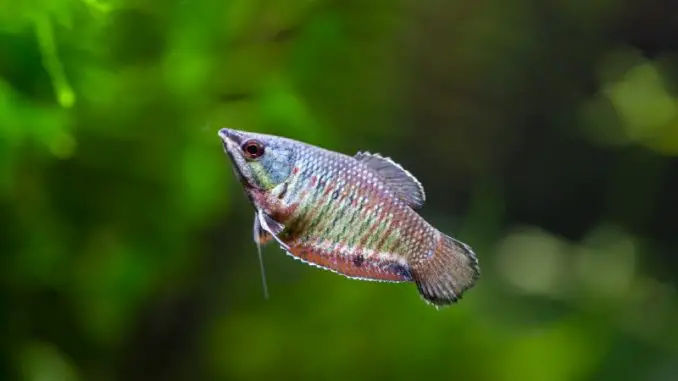
The samurai gourami is a shy species of freshwater fish from the Osphronemidae family that is rarely seen in home aquariums or its native habitat in the Indonesian part of Borneo.
This fish is also called the Vaillant’s chocolate gourami and samurai zebra gourami.
Samurai gouramis are one of many types of gourami fish and have specific care requirements. These fish prefer dim lighting, acidic water, high temperatures, and plenty of hiding spaces in the tank.
This unique species of gourami is not suitable for beginner aquarists due to the high level of care it needs. It can coexist with other bottom-dwelling fish or in groups of six to eight of the same species.
TABLE OF CONTENTS
Samurai Gourami Facts & Overview
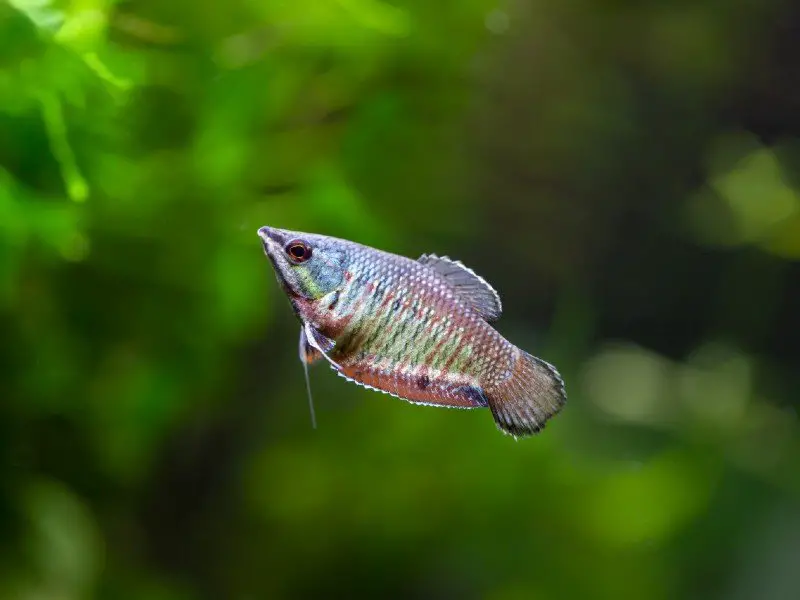
| Category | Rating |
| Care Level: | High |
| Temperament: | Timid |
| Color: | Males are browny grey and females are green with red stripes |
| Lifespan: | 5–8 years |
| Size: | 1.8–2.2 inches |
| Diet: | Omnivore (live fish food) |
| Family: | Osphronemidae |
| Minimum Tank Size: | 20–30 gallons |
| Tank Set-Up: | Freshwater, dim lighting, natural arrangement |
| Compatibility: | None, or bottom-dwelling such as corydoras |
The scientific name for samurai gourami is Sphaerichthys vaillanti and it is found within the Osphronemidae family.
The samurai gourami originates from Southeast Asia, in the Indonesian part of Borneo within the Kalimantan River. The fish come from blackwater areas populated with tree roots and other decaying materials. Samurai gourami can be mistaken for dead leaves as they swim along the bottom of the riverbed.
Owners will need to copy this habitat in the aquarium by adding plenty of natural foliage in the tank and keeping the pH level between 4.0 and 5.0.
Thriving in oxygen-depleted rivers, the fish breathe through organs shaped like a labyrinth. This labyrinth breathing organ allows them to breathe from the surface of the water.
Samurai gouramis usually live between five to eight years. The life expectancy depends on the gouramis’ tank conditions. Less than optimal tank conditions result in a lower life expectancy.
Samurai gouramis are rare in the wild and are hard to find in pet stores. The fish are available to buy from online sites such as Aqua Imports. The price of the fish ranges between $19 and $30, but this price is often higher due to scarcity.
Appearance & Behavior
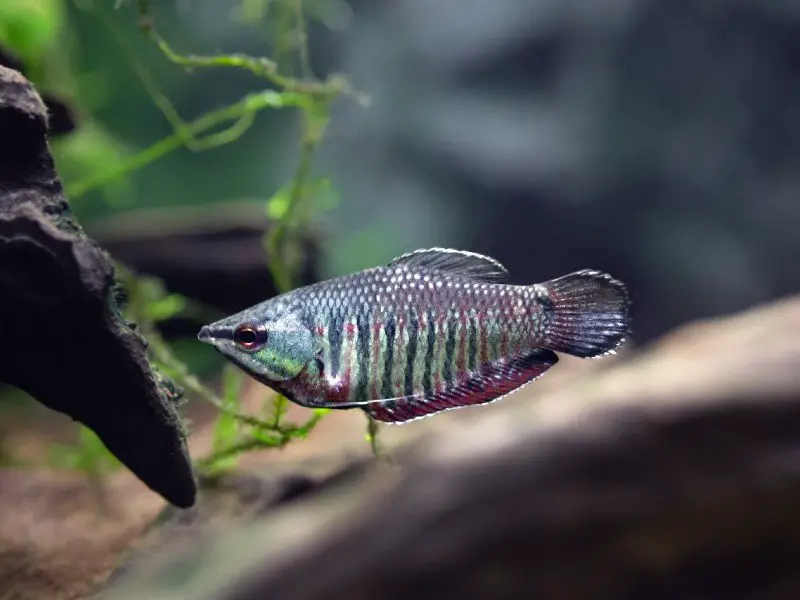
Female samurai gouramis are bright and colorful to attract male fish. Differentiating between female and male samurai gouramis is difficult when the fish are young. The young fish are light brown, giving them ample disguise among decaying leaves.
As the fish grow, they become easier to distinguish. Mature female samurais take on a bright green color with bold red and green stripes down their sides.
The females have green scales towards their heads, while their tail end is red. Female samurais have a pointed face with a long straight jaw.
The males are dull in comparison to females with lightish grey and brown coloring. The males have a rounder mouth with extra skin below it that expands when they hold the fry inside their mouths.
Male samurais have a vertical stripe situated between the anal and dorsal fins.
The coloring of male samurai gouramis is also pronounced during courtship. Male and female fish look brighter and more colorful during spawning.
Adult samurai gouramis will grow to anywhere between 1.8 and 2.2 inches long. Fish living in appropriate aquarium conditions grow to their full potential. Incorrect care and tank conditions could result in small-sized fish.
Typical Behavior
Samurai gouramis are timid fish that prefer to hide close to the bottom of riverbeds. The fish often blend in with the decaying plant matter around them. In a tank, these fish will behave in similar ways and will need lots of foliage to hide in. Samurai gouramis are likely to drift at the bottom of the tank when not hiding.
Males can get aggravated if the water temperature is too high. Due to the shy nature of the samurai gourami, you will need to choose tankmates with care.
Slow-moving fish that are peaceful are the best tankmates for samurai gouramis, such as boraras, microrasbora, pangio, or bottom-dwellers like corydoras. Boisterous fish are bad tank mates for samurai gouramis.
Samurai gouramis work best in groups, so you should buy a group of at least six for a 30-gallon tank. A group of samurais produces better breeding pairs and is interesting to watch. There should be more females than males to prevent aggressive behavior during breeding.
Samurai gouramis are mouthbrooders. The male keeps the eggs in his mouth for seven to 21 days. The males do not eat during this time, and if they do, they eat a small amount. The female protects their surroundings as the fish wait for the eggs to hatch.
Samurai Gourami Care
Samurai gouramis are difficult to look after. These fish are not recommended for beginner aquarists. This rare species of fish need low lighting to mimic its natural habitat of peat swamps.
Samurai gouramis are omnivorous and picky eaters. Feed samurai gouramis live fish food before adding some frozen food to the diet.
Samurai gouramis develop the same diseases and infections as other tropical freshwater fish. Samurai gouramis may develop harmful diseases if the pH level of the water is incorrect.
Disease
Samurai gouramis can pick up bacterial, parasitic, or fungal infections. Samurai gouramis will get sick easily if the tank conditions are not optimal. Bad conditions may be caused by an incorrect pH balance, which you can test with the best pH meter.
Samurai gourami can develop infections if they are not well looked after. If the previous pH level was incorrect, you should ease it back to normal as soon as possible.
Pollutants in the water such as nitrates can cause infection for samurai gouramis. A warning sign of a high nitrate level is if the samurai gourami’s color darkens or the fins turn redder than usual.
Samurai gouramis change color slighting during mating season, so color changes are often normal. Performing regular water checks will help prevent nitrate-related diseases.
Intestinal worms are another common samurai gourami condition. Aquarists sometimes mistake bloating in female fish for a fish that is ready to breed. Intestinal worms cause bloating and need urgent medical attention.
Habitat and Tank Requirements
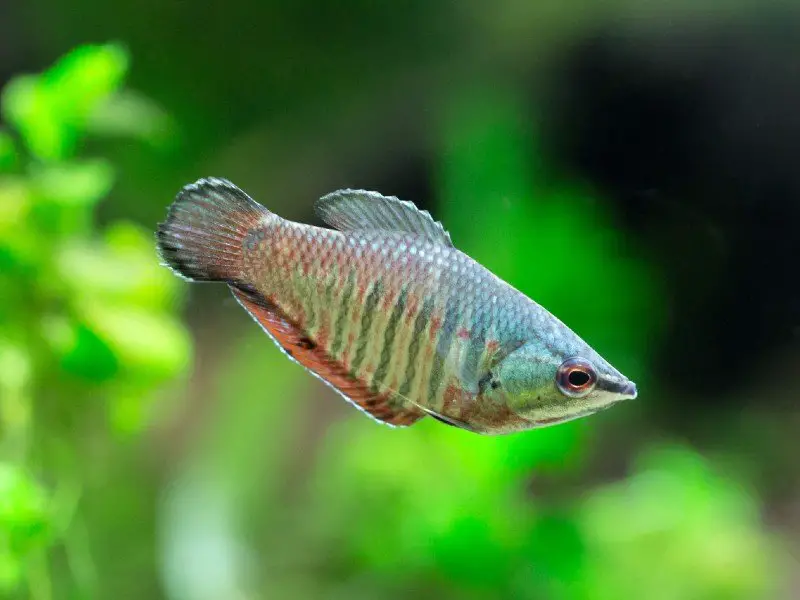
Wild samurai gouramis survive in acidic peat swamps and in slow-moving or still river systems filled with tannin. The fish’s natural environment contains debris, decaying leaves, and other foliage. These areas are also filled with tree roots and are covered by dense vegetation.
Samurai gouramis live in acidic water. The plant matter in the river makes the water acidic. Samurai gourami may live in some clear water areas, but these fish are usually found in blackwater. The decaying materials found within the river stain the water a darker color.
Tank Conditions
Samurai gourami tanks should be set up in a similar way to the fish’s natural environment. This setup will keep your fish happy and healthy. A 30-gallon tank is the right size to fit a group of up to eight samurai gourami.
Prepare a blackwater tank with a pH level between 4.0 and 5.0. To maintain the right acidity, filter the tank water through aquarium peat. The tannin levels in the tank should remain elevated with low nitrate levels.
Samurai gourami lives in water temperatures of 70 to 80°F. The temperature should be higher when the males are brooding. If the temperatures drop too low during brooding, the males could die.
Male samurai gouramis can become aggressive in high water temperatures. Male fish should be monitored and placed in a separate breeding tank during brooding.
Samurai gourami prefers a tank set up with little water flow that mimics still-water rivers. Reduce the water flow in the tank by connecting a filter with an adjustable outflow or use a baffle.
Take care when changing the tank water. Samurai gouramis live in areas with water that don’t change often. Therefore these fish don’t need frequent water changes in the aquarium. Water changes should happen over a longer period with no more than 15% of the water changed each week.
Samurai gouramis need plenty of plant matter inside the tank to let them blend in and hide. Flower pots and plastic accessories are good in a samurai gourami tank as long as the accessories provide enough shelter.
A tank set up with natural elements will make the samurai gourami more comfortable. Include plenty of live plants, wood, and leaves in the aquarium. For example, you can learn how to make driftwood for your aquarium as a natural addition.
Including Indian almond leaves in the tank setup is a good idea as the decaying leaves will produce enough tannin to stain the water. Aquarists can let the leaves decay naturally or replace them leaves every few weeks. This setup would be the most beneficial to the fish as it is closest to the fish’s natural habitat.
Tank Mates
Samurai gouramis prefer to share a tank with groups of their own species. There should be at least six samurai gourami per tank to create prime breeding conditions.
Samurai gouramis can coexist with other species as long as the tank mates are not boisterous fish. Samurai gouramis show aggression while breeding and this causes issues with tank mates.
A bottom-dwelling corydoras are a good option as tankmates for samurai gouramis. Pangio species such as the kuhli loach are another option as they are calm and hide during the day.
Harlequin rasbora, rosy barbs, and certain tetra fish require a similar tank setup to samurai gouramis, making these fish good tank mate options.
Pair samurai gouramis with non-fish tank mates such as mystery snails, dwarf crayfish, and amano shrimp. These non-fish additions can bring your tank setup to life without disturbing the samurai gourami.
Diet and Feeding
Samurai gouramis are omnivorous feeders in their natural habitat. The fish are picky eaters and tend to prefer insect larvae, worms, small crustaceans, and zooplankton over plant matter.
Samurai gouramis will likely reject dry food and prefer live fish food which also keeps them healthy. The fish can be weaned off live fish food onto frozen food if necessary, but this should be done slowly to help them adjust.
You should feed samurai gouramis a varied diet of live (and frozen) brine shrimp, micro worms, mosquito larvae, and daphnia grindal. You should feed your samurai gouramis twice daily in small amounts. Do not feed samurai gourami more than they can eat in two minutes unless they need to hunt their prey first.
Feed the samurai gouramis extra food before they begin spawning. Samurai gouramis should be fed a varied diet of live fish food and fresh vegetables such as lettuce and spinach.
Breeding
Samurai gouramis are mouth breeders. Female samurai gouramis drop the eggs on a safe surface after breeding. The males fertilize and then collect the eggs in their mouths. During brooding the females protect the habitat while the males stay hidden to protect the eggs.
Male samurai gouramis hold the fry in their mouths for seven to 21 days before releasing them into the tank.
At the start of the breeding season, the samurai gouramis become brighter in color. The female samurai gouramis are the first to begin the spawning process. Spawning fish remain upright for hours. The female will lay anywhere between 10 and 40 eggs on a safe surface within the tank.
Use a breeding tank that is set up like the main tank for the mating gouramis. The male gourami should stay in the breeding tank with the eggs with plenty of spaces to hide after spawning. Increase the water temperature slightly to keep the male safe.
Once the male fish releases the fry, he can move back to the community tank. This will prevent the male from eating the fry.
Feed newly born fry micro worms or baby brine shrimp. The breeding tank must stay warm to allow the complex labyrinth system to fully develop.
Should You Get a Samurai Gourami for Your Aquarium?
Seasoned aquarists will enjoy keeping samurai gouramis as the fish liven up a home aquarium. Samurai gouramis need a high level of care and a specific setup to live and breed optimally.
If you are considering adding samurai gourami to your tank at home, you should be well-prepared and have a tank ready ahead of time.
Despite the difficulty of looking after the samurai gourami, it is a rare breed of tropical fish that can create a dynamic and exciting tank setup for your home.
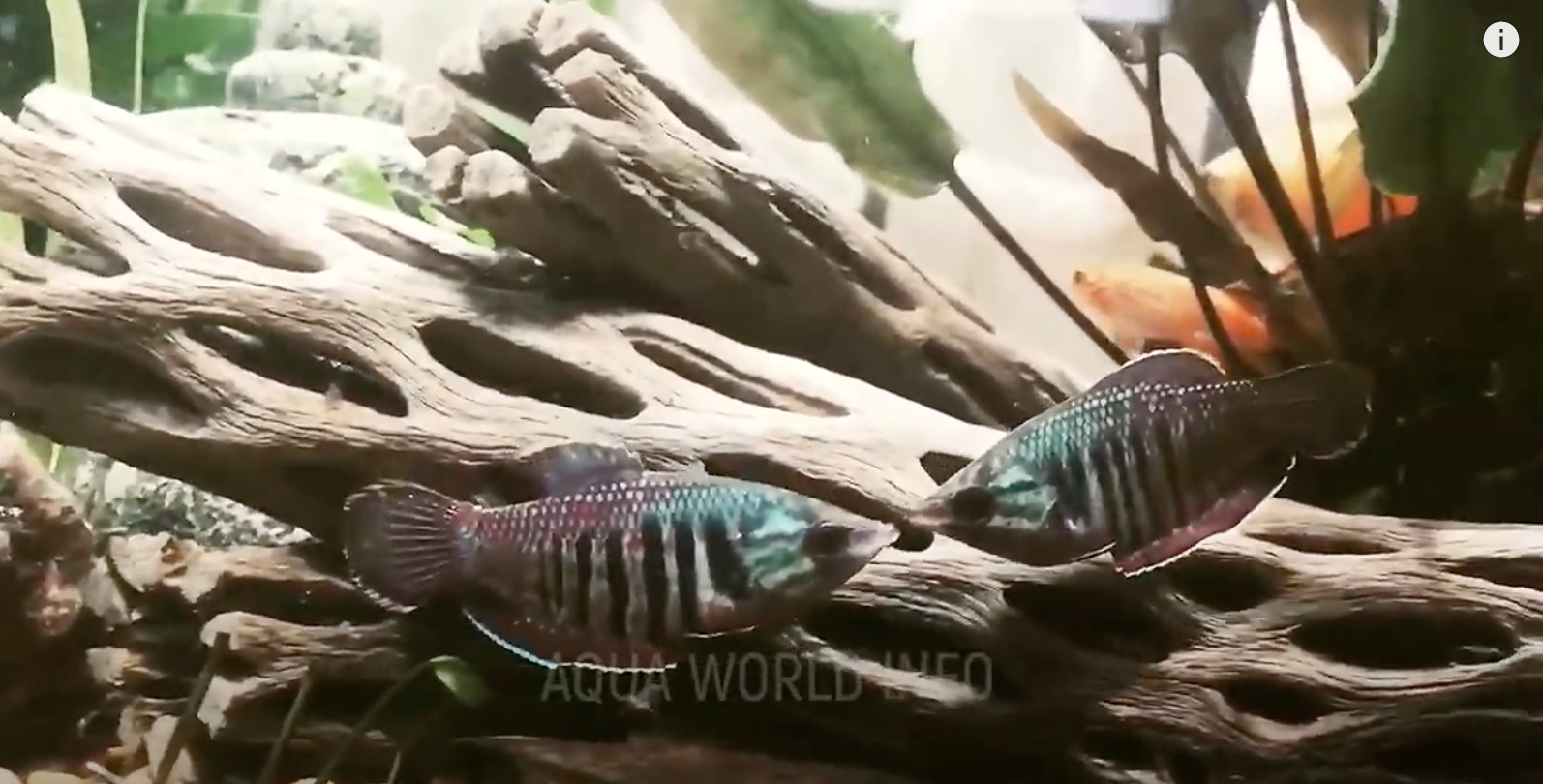


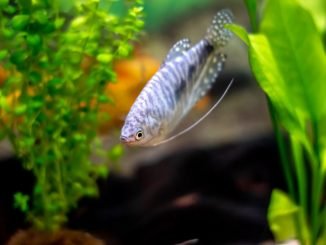



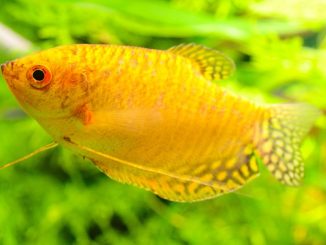
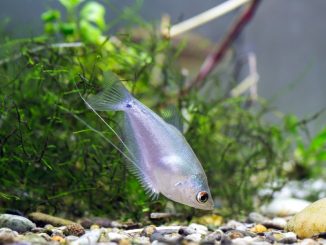
Be the first to comment